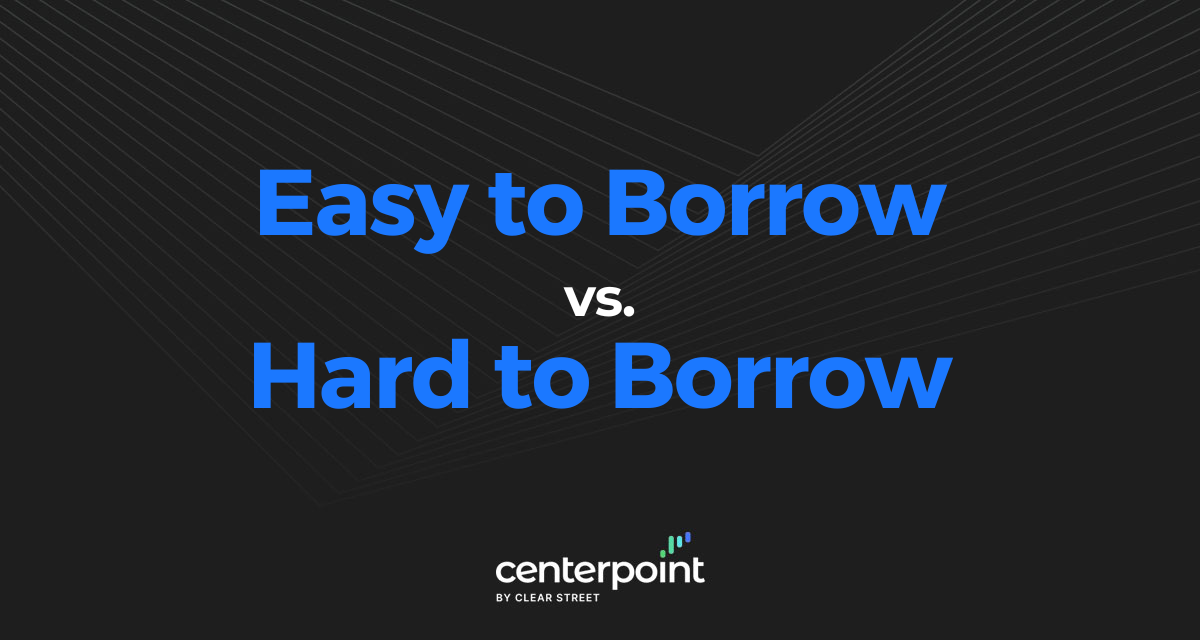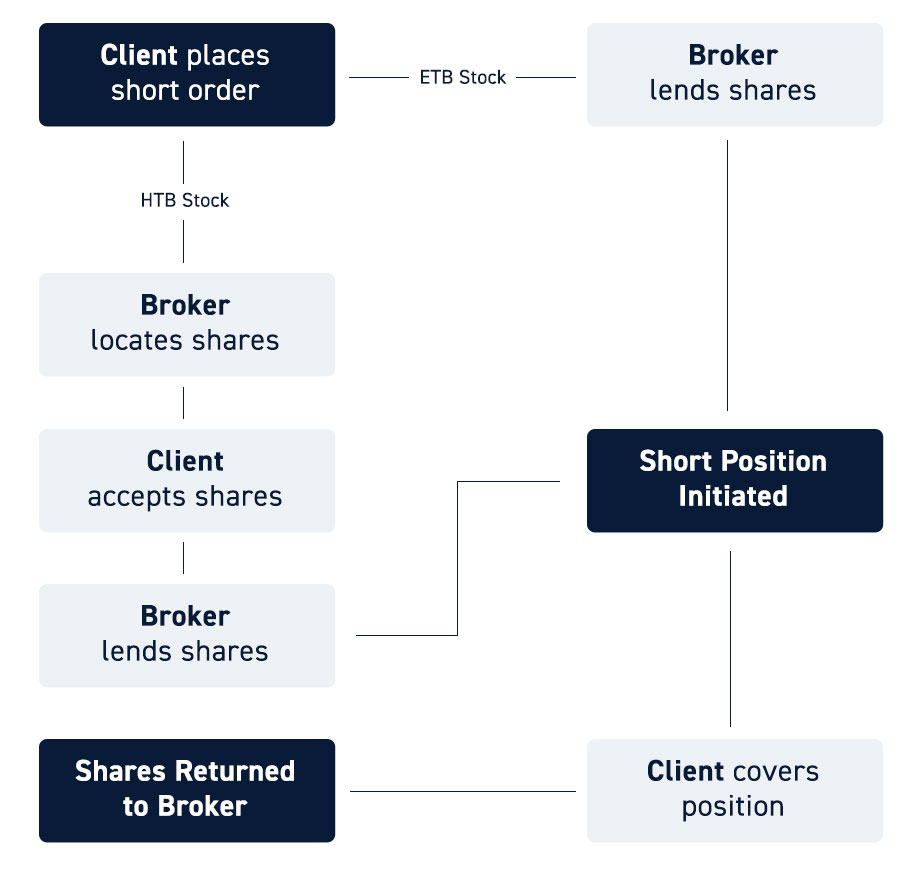The adage, “buy low and sell higher” underscores the strategy for taking a long position – a strategy that largely dominates the market. Whether you’re a trader or an investor, the goal is to capture a profit from rising shares prices.
On the flip side, you can also capture profits when share prices are falling, which can be thought of as “selling high and buying (back) lower.” This activity is called short selling, which is performed by selling a stock with the intent to buy back lower so you can keep the difference as profit.
In order to sell shares of a stock you don’t own, the shares must first be “borrowed” from someone willing to lend them. This process can be difficult to grasp for those new to short selling, so let’s take a minute to see how it works.
What is a “Borrow”?
When you short sell a stock, you are selling something you don’t own and taking a negative position. This begs an answer to the question, “How can you sell something you don’t actually own?”
The short answer is that you are borrowing shares that you will return at a later point. Compare this to a real-world situation.
iPhones are selling for $1,000 and you believe they will be worth $800 a week from now. You don’t own an iPhone but you want to find a way to profit from your prediction. You decide to ask your friend to borrow his iPhone. He agrees to lend you the phone which you proceed to sell for $1,000. A week later, the price of iPhones drops to $800, at which point you purchase an iPhone to return to your friend.
You made $200 and your friend gets his iPhone back (and maybe some interest) – everyone is happy.
Now, let’s get back to stocks.
The Mechanics of Short Selling
Most trading platforms provide a separate button or tab labeled “Short”, “Short Sell” or “Short to Open” that allows traders to initiate a short sell order.
When a trader initiates a short order, the broker determines if there is enough short inventory available to lend shares to short. If the stock is immediately available to short (also known as “easy-to-borrow (ETB)”), then the order is placed as if you were selling shares normally. If shares are hard-to-borrow (HTB), the broker will need to find a way to borrow shares, and the stock is classified as “locate required.” This generally requires a request to locate shares (also referred to as a “short locate”). The shares may still be borrowed to short, but the broker must locate shares first since the shares are not readily available (hence, the classification “locate required”).
What Determines Whether a Stock is Easy to Borrow?
The broker’s clearing firm determines which stocks are immediately available to lend out for short sales. Most widely traded stocks (i.e. S&P 500 index stocks) are on the ETB list. However, they may occasionally end up on the “locate required” list along with less liquid stocks.
The indication of whether a stock is ETB or requires a locate is governed by the broker’s clearing firm. Clearing firms technically custody the stock and decide on the availability of shares. Availability is based on various factors including liquidity (supply versus demand), volatility (both in terms of micro and macro), short interest/short percentage (%) of float and volume (based on multiple of average daily volume). For example, a stock that requires a locate might be a small-cap stock with a small float (i.e. 15 million shares) with high short interest (i.e. 35%+) trading at over 5X normal volume with share prices surging up over 40% on the day.
These factors are always dynamic so shares can migrate from ETB to HTB (locate required) throughout the same trading day. Keep in mind that even when locates are available, the number of shares can be scarce and may not easily be replenished.
How Are HTB Stocks Different Than ETB Stocks?
Shorting stocks that require a locate is much different than shorting ETB stocks. Due to their rarity, stocks that are hard-to-borrow will usually require a “short locate” request with your broker. Since the broker has to actively search for shares, there are usually fees applied if the request is fulfilled and accepted.
Additionally, there may be higher margin requirements and margin interest associated with the located stock to risk factors like extreme volatility. It’s very important for traders to stay abreast of the maintenance margins and short interest rates on stock locates as they can change intraday.
Short Squeezes and Margin Calls
If you fall under the maintenance margin, it can trigger an intraday margin call. Your broker may initiate forced liquidation to bring the account back under the maintenance margin levels.
The process of forced liquidation, where short positions are automatically covered, can further spike buying activity to sharply spike share prices even higher fueling a short squeeze. A short squeeze triggers a frenzy of buying as desperate short sellers frantically try to control losses by covering their positions. To further induce panic, the availability of short inventory shrinks or evaporates thereby trapping short sellers with no ability to scale or average their positions.
Stocks that require locates are often the most susceptible to short squeezes, therefore caution and prudent decision making is critical.
What if I Can’t Find Shares to Borrow at All?
The availability of hard-to-borrow shares largely relies on market conditions and your broker’s clearing firm. Not all clearing firms are equal nor do they accommodate all participants in the markets.
Mainstream online brokers may self-clear and decide to keep short inventory limited due to their broader risk averse customer base.
Direct market access (DMA) brokers may use independent clearing firms that accommodate more sophisticated, experienced and risk tolerant customers like active traders. These firms may have better access to short locates or relationships with other clearing firms with extensive short inventory.
If short selling is a big part of your strategy, you will need a broker that can accommodate you. If you do not have the ability to borrow shares for a short position, you will be forced to sit on the sidelines. In reality, it is impossible to secure locates on every stock you want to short. However, choosing a broker that specializes in short locates will help you out immensely.
Is Short Selling for Everybody?
No, short selling is not for everybody. You should have a high-risk tolerance if you plan on implementing short selling strategies. Short selling comes with additional risks generally not associated with buying long. For starters, when you buy a stock, the maximum amount you can lose on the trade is limited to the total cost of the purchase. When you sell a stock short, the maximum loss is unlimited. On the long side, the stock’s price cannot go below zero. On the short side, there is no limit on how high the price can go. There are also fees that can be much higher on the short side than the long, such as short interest charges and locate fees. Be sure to talk to your broker if you do not have a thorough understanding of the fees associated with selling short.










